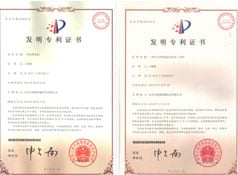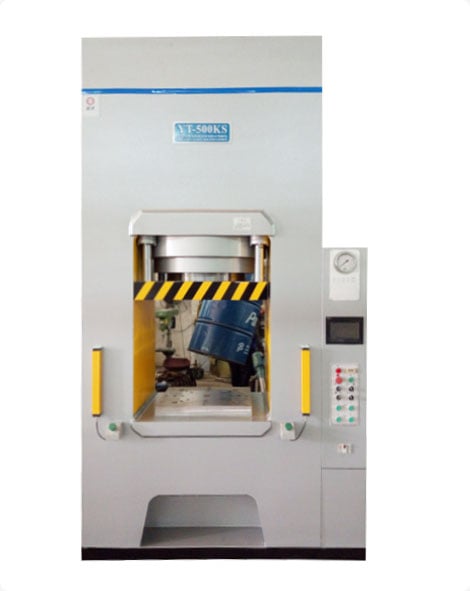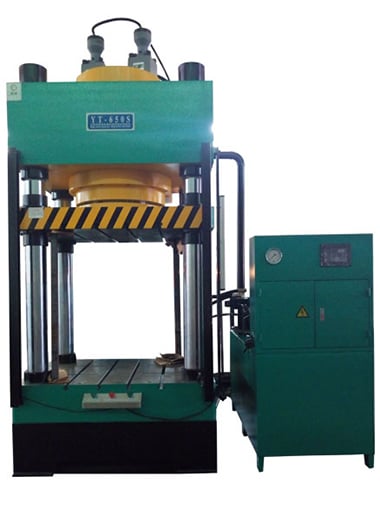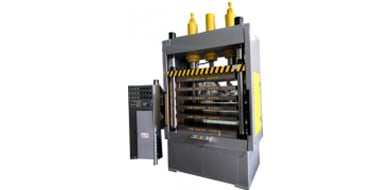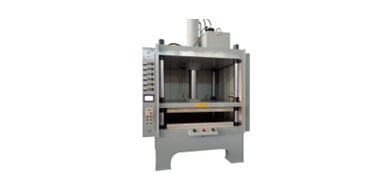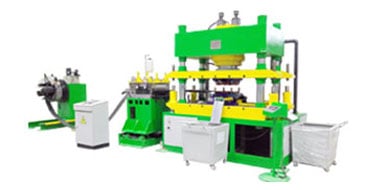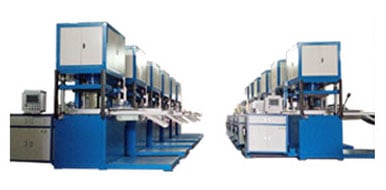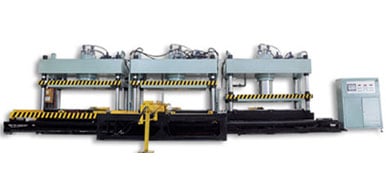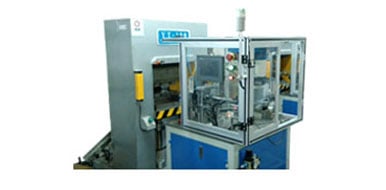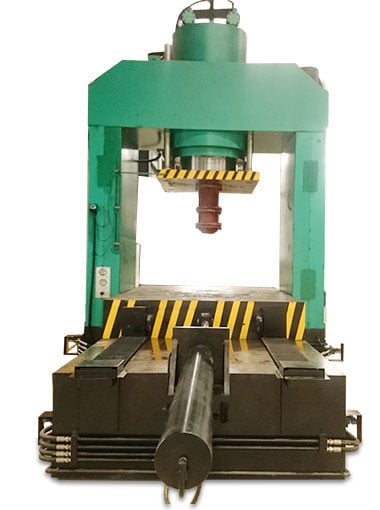How to Make a Hydraulic Press at Home
time:2023-08-29 views:(点击 1,009 次)If you need to apply substantial pressure to materials, a hydraulic press can help. DIY-ers can make one at home easily - with no preliminary drawings necessary!
Just build a frame and main mounting for the pump and cylinder, and it should work just fine!
Frame
A hydraulic press utilizes Pascal's principle to generate massive amounts of force, making it ideal for various projects such as bending, drawing and punching. Its basic concept consists of two cylinders connected by pipes that create pressure against one another; with one slave cylinder working against its master counterpart to exert the required force on material.
Hydraulic presses come in an assortment of sizes and are widely used across various industrial applications. They can be used to forge metal, form plastics, press wood and even bend and blank sheet metal sheets for sheet metal work including bending, blanking, forming deep drawing stamping. Furthermore, hydraulic presses offer greater versatility over other forms of industrial presses while offering greater flexibility with greater longevity than their alternatives.
To successfully build a hydraulic press at home, several essential items will be required. First is a sturdy frame; this may be made out of various materials; however, steel will prove stronger and last longer.
Assembling your hydraulic press will require both a hydraulic cylinder and pump. Both can be found easily online or at local hardware stores. Once all parts have been collected, assembly should begin immediately - ensure all connections are securely bolted or welded for leakage or damage prevention, while selecting an extra strong cylinder that has a high load capacity if possible.
Hydraulic presses can be invaluable tools in any workshop, yet finding one is no simple matter. Not only is there a cost associated with purchasing one; you also require experience working with hydraulics in order to make the most of it. Constructing one yourself may take longer, but the results make the effort worth your while if you want the power of professional-grade presses in your own garage.
Cylinder
Hydraulic cylinders (or hydraulic rams), commonly referred to as cylindrical devices powered by pressurised fluid, can provide immense power. Each hydraulic cylinder contains two chambers - one at the bottom known as "cap end," and another near its piston rod side ("rod end"). Sliding rings and seals keep fluid contained within the cylinder for efficient functioning; typically these cylinders are used for lifting and jacking tasks.
The cylinder is at the core of any hydraulic system and can be made of various materials, with steel being among the best options for corrosion protection and withstanding harsh environments found in industrial machines. Honed steel cylinders offer optimal corrosion protection while also being highly suitable for industrial use due to this process of applying an abrasive to create precision finishes on metal surfaces. Honed steel is particularly suited for use as industrial machines often create harsh environments, providing increased corrosion protection.
When designing a hydraulic cylinder, it is crucial to take into account its application and intended use. A good starting point should be calculating the weight of the load you will be lifting before selecting a cylinder with sufficient capacity. In many instances, however, selecting one with more capacity than anticipated allows for any unexpected shifts or fluctuations in weight distribution or any unexpected surprises that arise during its usage.
Hydraulic cylinders come in various sizes and lifting points, so they can be tailored to meet specific requirements such as the number of lifting points or rating requirements. There are many aspects to keep in mind when purchasing a hydraulic cylinder such as its size and pressure capacity.
Homemade hydraulic presses can be an indispensable asset when applying large amounts of pressure. Their design draws inspiration from French mathematician Blaise Pascal's research between 1647 and 1648 into fluids, pressures and vacuums - specifically when exerting force over an area where fluid exists; when this occurs pressure increases equally around it in all directions - known as Pascal's Law.
Pump
A hydraulic press uses fluid pressure to crush objects. It comprises of a frame, two end plates, and a pump that elevates its pressure of hydraulic fluid. A hydraulic press can be used for metalworking applications as well as stamping, molding, drawing, punching, coining, stretching and stretching applications - it may even be used pull samples apart for tension testing purposes!
A hydraulic press works on Pascal's principle-the pressure throughout a closed system remains constant. To operate, pressurize a piston against an anvil or die and push back with greater force than was initially applied mechanically by applying force from below; these disparate forces result from differences between cylinder sizes and hydraulic fluid pressure; for optimal results use quality, low-pressure hydraulic fluid.
Hydraulic presses come in many varieties and they all operate differently. Some have multiple cylinders while others utilize just one. A common design features one cylinder carrying the ram with larger diameter than its plunger counterpart - these interconnecting cylinders transmit hydraulic fluid pressure directly from plunger to ram for use in pressing operations.
Make your own hydraulic press at home easily by following some basic prompts. Assembling this machine is straightforward and anyone with welding machine experience or bolted connection experience can assemble one safely. No electrical wiring is required for operation - however you should select a jack which can withstand the amount of pressure you plan to apply when operating it.
Hydraulic presses can be constructed out of different materials, from wood to aluminum and steel. A hydraulic press is an invaluable tool when creating something new; however, misuse could prove dangerous; for this reason it is wise to abide by any instructions that come with the machine.
Before purchasing a hydraulic press, it's also essential that you learn how to operate it. YouTube offers several videos showing people using one to crush everyday items such as bottles and car parts - some even educational!
Jack
Hydraulic presses make it possible to perform tasks such as clinching, moulding, punching, deep drawing and metal forming operations, as well as automotive industry plastic molding operations. Since industrial-sized hydraulic presses can be expensive and cumbersome to transport, many people opt to build smaller hydraulic presses at home using standard bottle jacks; such homemade presses can then be used to crush tires or hard materials while providing DIY tool functionality in the garage - though keep in mind they must always be operated responsibly for safe use!
When creating a hydraulic press, it's essential that the cylinder and pump are the appropriate sizes. While this may prove challenging if you lack experience in mechanical engineering or physics, by following instructions carefully you can build an effective home press.
Once your frame is complete, the next step should be adding the hydraulic cylinder and pump. These tools serve to press down on workpieces while simultaneously pumping up pressure with their hydraulic fluid source. Cylinders may be made out of any material such as steel or aluminum for ease of use and damage prevention; typically they should be as large as your workpiece to avoid miscalculations or errors in measurements.
To make sure the hydraulic cylinder is correctly situated, using either a laser or tape measure to mark its dimensions can help you ensure its centering on the workpiece for greater accuracy and efficiency.
A specialized hydraulic jack known as a "strand jack" is often employed in construction and engineering projects, lifting hundreds of tons with compressed air or standard hydraulic mechanisms. This device enables users to avoid manual labor while saving energy and speeding up processes.
Choose a spring that satisfies both these criteria for an effective jack, both strong and flexible enough to return the site back to its initial condition. A too-stiff spring can delay technological processes by forcing machines to sit idle for extra seconds or minutes; selecting an optimal stiffness spring will lower energy costs while increasing performance.
Link to this article: https://www.ihydraulicpress.com/nsn/4472.html
Hot Articles
-
How to Make Almond Oil With Hydraulic Press
Almond oil is an integral component of many beauty and health products, offering anti-ageing benefits for hair and skin while being chock full of ……
-
How to Make a Wooden Hydraulic Press
An essential piece of equipment in any garage, a hydraulic press can easily be made at home to save both money and effort in purchasing an expensi……
-
How to Make an Air Over Hydraulic Press
Air over hydraulic presses offer an energy-efficient and quieter alternative to full hydraulic presses, and are easier to maintain with fewer part……
-
How to Make Small Hydraulic Press at Home
Hydraulic presses play an integral part in many manufacturing and production processes. They can shape machine components as well as crush materia……
-
How to Make Electric Hydraulic Press
Electric hydraulic presses play a pivotal role in many industries for fabrication, assembly and maintenance activities. These presses use pressure……
-
How to Make a Hydraulic Press Brake
Hydraulic press brakes are industrial machines used to bend sheet metal using pressure. Their force depends on the size and thickness of material ……
-
How to Make a Hydraulic Press
It can be used for crushing cars Hydraulic presses are one of the most indispensable machines used in industrial manufacturing. From making cars t……
-
How to Make Hydraulic Press Substitute
Nothing stands in the way of crushing anything with a hydraulic press, provided it’s large enough. But this task may require more than a Termi……
Latest News
-
How to Make a Hydraulic Press at Home
Hydraulic presses can be invaluable tools in any garage, whether for pressing bearings and silent blocks into shape, or compressing organic waste ……
-
How to Make a Hydraulic Press Brake
Employing mechanical forces to bend and shape sheet metal can be challenging. Press brakes are machines which use pressure and clamp dies to bend sh……
-
How to Make a Hydraulic Heat Press Machine
Hydraulic presses are machines that utilise hydraulics pressure to generate force, typically used to compress objects or shape metals. Pneumatic ros……
-
How to Make a Simple Hydraulic Press
Hydraulic presses are widely utilized tools that employ extreme amounts of pressure over an extended period or in quick succession, and are widely……
-
Hydraulic Press Channel
The Hydraulic Press Channel on YouTube features Lauri Vuohensilta crushing things with his hydraulic press in entertaining videos that draw millio……
-
How to Make a Homemade Hydraulic Press
Hydraulic presses play an integral role in many metalworking processes, from shaping machine components to compacting waste material. They offer v……
-
Hydraulic Press Channel – How Much Does Hydraulic Press Channel Make?
The Hydraulic Press Channel features Lauri Vuohensilta crushing objects using his family’s industrial hydraulic press. This channel has beco……
-
How to Make a Blacksmith Hydraulic Press
A forging press is an indispensable tool in modern blacksmithing, performing many of the same functions as a power hammer but with greater control……


